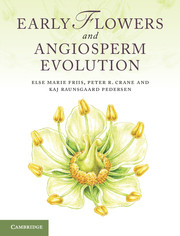Book contents
- Frontmatter
- Contents
- Preface
- 1 Introduction to angiosperms
- 2 The nature of the angiosperm fossil record
- 3 The environmental context of early angiosperm evolution
- 4 Stratigraphic framework and key areas for Cretaceous angiosperms
- 5 Angiosperms in context: extant and fossil seed plants
- 6 Origin and age of angiosperms
- 7 Phylogenetic framework and the assignment of fossils to extant groups
- 8 Fossils near the base of the angiosperm tree
- 9 Early fossil angiosperms of uncertain relationships
- 10 Early fossils of eumagnoliids
- 11 Fossils of monocots
- 12 Fossils of eudicots: early-diverging groups
- 13 Fossils of core eudicots: basal lineages
- 14 Fossils of core eudicots: rosids
- 15 Early fossils of eudicots: asterids
- 16 Patterns of structural diversification in angiosperm reproductive organs
- 17 History and evolution of pollination in angiosperms
- 18 History and evolution of dispersal in angiosperms
- 19 Vegetational context of early angiosperm diversification
- 20 The accumulation of angiosperm diversity
- References
- Index
17 - History and evolution of pollination in angiosperms
Published online by Cambridge University Press: 07 September 2011
- Frontmatter
- Contents
- Preface
- 1 Introduction to angiosperms
- 2 The nature of the angiosperm fossil record
- 3 The environmental context of early angiosperm evolution
- 4 Stratigraphic framework and key areas for Cretaceous angiosperms
- 5 Angiosperms in context: extant and fossil seed plants
- 6 Origin and age of angiosperms
- 7 Phylogenetic framework and the assignment of fossils to extant groups
- 8 Fossils near the base of the angiosperm tree
- 9 Early fossil angiosperms of uncertain relationships
- 10 Early fossils of eumagnoliids
- 11 Fossils of monocots
- 12 Fossils of eudicots: early-diverging groups
- 13 Fossils of core eudicots: basal lineages
- 14 Fossils of core eudicots: rosids
- 15 Early fossils of eudicots: asterids
- 16 Patterns of structural diversification in angiosperm reproductive organs
- 17 History and evolution of pollination in angiosperms
- 18 History and evolution of dispersal in angiosperms
- 19 Vegetational context of early angiosperm diversification
- 20 The accumulation of angiosperm diversity
- References
- Index
Summary
Pollination, the successful transfer of pollen from the pollen sacs (microsporangia) into proximity with the ovule, is the essential precursor to fertilisation and therefore to sexual reproduction in seed plants. Pollination has been studied most intensively in angiosperms, although few species have been examined in detail compared with the great variety of flowers within the group (e.g. Proctor et al., 1996; Thien et al., 2009). Pollination in extant non-angiosperm seed plants has received less attention, but studies over the past few decades now provide a more complete context within which pollination in angiosperms can be evaluated and studied (e.g. Owens et al., 1998).
Interpretation of pollination in extinct plants faces significant difficulties. Only rarely is there relatively direct evidence of flower–pollinator interactions (e.g. insect gut contents, coprolites, insects preserved within flowers, insects carrying pollen) and interpretations of pollination in extinct plants therefore depend heavily on extrapolations to extant taxa based on structural similarities. This often leads to plausible interpretations, but it may also be constraining. There is no a priori reason why the spectrum of plant–pollinator interactions existing today should also include all of those that existed in the past, and inferring floral function from floral structure, even in extant plants, can sometimes be difficult. It is therefore especially challenging to infer pollination in extinct seed plants (e.g. Caytonia, Bennettitales) that have no clear close living relatives.
- Type
- Chapter
- Information
- Early Flowers and Angiosperm Evolution , pp. 415 - 444Publisher: Cambridge University PressPrint publication year: 2011
- 2
- Cited by

